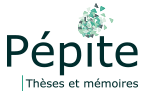Caractérisation des troubles du langage post-AVC et corrélats neuro-anatomiques
- AVC ; troubles du langage ; évaluation orthophonique ; fonctions exécutives ; corrélats neuro-anatomiques ; VLSM ; base de données
- Stroke ; language disorders ; executive functions ; neuroanatomical correlate ; VLSM ; database
- Langue : Français
- Identifiant : ULIL_SMOR_2022_046
- Faculté/Ecole : Médecine
- Date de soutenance : 03/06/2022
- Type de mémoire : Mémoire de Master
- Discipline : Mémoire d'Orthophonie
Résumé
Les manifestations des troubles du langage post-AVC dépendent de l'impact des réseaux neuronaux cérébraux. Les liens entre lésions cérébrales et symptômes sont identifiables avec la méthode d'imagerie voxel-based lésion symptom mapping (VLSM). Par ailleurs, la part des troubles cognitifs dans les troubles langagiers demeure souvent difficile à établir. A partir des scores obtenus par des patients lors de bilans orthophoniques réalisés dans un service de rééducation du CHU de Lille, nous avons constitué une base de données. Nous avions quatre objectifs : décrire les troubles langagiers post-AVC, analyser les corrélations entre ces troubles ainsi qu'avec les troubles exécutifs et attentionnels, et débuter l'analyse des corrélats neuroanatomiques à partir de la technique VLSM. Les résultats nous ont permis une première caractérisation de la population et des troubles langagiers et d'observer des corrélations entre eux. En revanche, nous n'avons retrouvé que peu de liens significatifs entre les troubles langagiers et cognitifs, probablement en raison des faibles effectifs de patients évalués dans ces deux domaines. Enfin, nous avons utilisé la technique VLSM pour identifier les lésions responsables des scores pathologiques obtenus en compréhension syntaxique et dénomination orale. Les résultats trouvés attestent de la faisabilité de la méthode et correspondent aux données de la littérature actuelle. L'enrichissement de la base de données créée permettra de préciser les liens entre troubles langagiers et cognitifs. A terme, cette recherche aidera la compréhension des symptômes langagiers post-AVC et leur prise en charge.
Résumé traduit
The manifestations of post-stroke language disorders depend on the impact of brain neural networks. The links between brain lésions and symptoms can be identified with the voxel-based lésion symptom mapping (VLSM) imaging method. Furthermore, the contribution of cognitive disorders to language disorders is often difficult to establish. From the scores obtained by patients during speech and language therapy assessments carried out in a rehabilitation department of the Lille University Hospital, we built a database. We had four objectives: to describe post-stroke language disorders, to analyse the corrélations between these disorders and with executive and attentional disorders, and to begin the analysis of neuroanatomical correlates using the VLSM technique. The results allowed us to characterise the population and the language disorders and to observe corrélations between them. On the other hand, we found few significant links between language and cognitive disorders, probably due to the small number of patients assessed in these two domains. Finally, we used the VLSM technique to identify the lésions responsible for the pathological scores obtained in syntactic understanding and oral naming. The results found attest to the feasibility of the method and correspond to the data in the current literature. The enrichment of the database created will help to clarify the links between language and cognitive disorders. Forward, this research will help in the understanding and treatment of post-stroke language symptoms.
AUTEUR
- Cellié, Cléo



